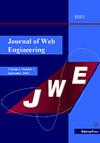Prediction and Performance Optimization of Hospital Web Application Access Modes Based on Big Data Analysis
IF 1
4区 计算机科学
Q4 COMPUTER SCIENCE, SOFTWARE ENGINEERING
引用次数: 0
Abstract
Data in hospital information systems contain errors, inconsistencies, and other issues that mask the true underlying patterns in the data, making the existing time series patterns blurry and leading to increased prediction errors in access patterns. To this end, research is being conducted on the prediction and performance optimization of hospital web application access patterns based on big data analysis. Firstly, semi-structured log data and structured information data from hospital web applications are collected and preprocessed. Then, a deep belief network (DBN) is used for feature extraction, and a deep learning model consisting of a stacked restricted Boltzmann machine (RBM) and a BP neural network is utilized to automatically extract multidimensional information such as user behavior features, temporal features, and page features, constructing a comprehensive feature system. Finally, based on the gated recurrent unit (GRU) neural network for access mode prediction, the control information selection mechanism of GRU is utilized to capture time series information and improve the accuracy of prediction. The experimental results show that the proposed prediction method has a practical application value with a mean square error of 0–50 for predicting traffic and a response rate within 5 seconds after application.基于大数据分析的医院Web应用访问模式预测及性能优化
医院信息系统中的数据包含错误、不一致和其他问题,这些问题掩盖了数据中真正的潜在模式,使现有的时间序列模式变得模糊,并导致访问模式中的预测错误增加。为此,正在开展基于大数据分析的医院web应用访问模式预测及性能优化研究。首先,采集医院web应用程序中的半结构化日志数据和结构化信息数据并进行预处理。然后,利用深度信念网络(DBN)进行特征提取,利用堆叠受限玻尔兹曼机(RBM)和BP神经网络组成的深度学习模型自动提取用户行为特征、时间特征、页面特征等多维信息,构建全面的特征体系。最后,基于门控循环单元(GRU)神经网络进行门禁模式预测,利用GRU的控制信息选择机制捕获时间序列信息,提高预测精度。实验结果表明,所提出的预测方法具有实际应用价值,预测流量的均方误差在0 ~ 50之间,应用后的响应速度在5秒内。
本文章由计算机程序翻译,如有差异,请以英文原文为准。
求助全文
约1分钟内获得全文
求助全文
来源期刊

Journal of Web Engineering
工程技术-计算机:理论方法
CiteScore
1.80
自引率
12.50%
发文量
62
审稿时长
9 months
期刊介绍:
The World Wide Web and its associated technologies have become a major implementation and delivery platform for a large variety of applications, ranging from simple institutional information Web sites to sophisticated supply-chain management systems, financial applications, e-government, distance learning, and entertainment, among others. Such applications, in addition to their intrinsic functionality, also exhibit the more complex behavior of distributed applications.
 求助内容:
求助内容: 应助结果提醒方式:
应助结果提醒方式:


